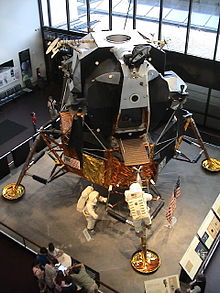- Owen Maynard
-
Owen Eugene Maynard (1924–2000) was a Canadian engineer who contributed to the design of the Canadian CF-105 Avro Arrow jet interceptor; and NASA's Apollo Lunar Module (LM). Maynard was a member of the group of 32 Canadian and British engineers from Avro Canada who joined NASA when the Arrow was cancelled in 1959. Maynard worked on Project Mercury until 1960 and then moved to the Apollo program. Maynard won a U.S. patent in 1967 for a space station design.
Contents
Early life
Owen Maynard was born in Sarnia, Ontario on October 27, 1924. He served in the Royal Canadian Air Force in World War II, and earned a BS in Aeronautical Engineering, from the University of Toronto, Ontario, in 1951.[1]
Career
In 1960, Maynard was part of the small group of engineers at NASA's Space Task Group. Later, the group became the Johnson Space Center. There, Maynard was assigned to the Apollo space flight program. .[2] By 1963, Maynard became chief of the LM engineering office in the Apollo Program Office in Houston, Texas. It was acknowledged at the time that Maynard was the person at NASA most responsible for the design of the LM, although most of detailed design work was done at Grumman Aircraft in New York under the direction of Thomas J. Kelly.[3] In 1964, Maynard was promoted to the position of chief of the systems engineering division in the Apollo Spacecraft Program Office, which put him in charge of systems integration for the Apollo spacecraft. He held this position for most of the remainder of his career at NASA, except for a time in 1966 and 1967 when he was chief of mission operations. While at mission operations, Maynard devised the “A” to “G” sequence for Apollo test flights leading to the first lunar landing on Apollo 11.[4]
Maynard left NASA in 1970, and went on to Raytheon in the Boston area. There he worked on many aerospace programs. He also became an advocate for the use of solar power collected on earth for powering spacecraft, and of satellites to collect solar power for the same usage on earth. In 1992, he retired from Raytheon, and he and his wife Helen returned to Canada, where they settled in Waterloo, Ontario, where he died on July 15, 2000.[5]
Awards and citations
- NASA Exceptional Service Medal (1969)
- Honorary Doctorate of Engineering, University of Toronto (1996)
References
- Notes
- ^ Gainor, Chris. Arrows to the Moon: Avro's Engineers and the Space Race. Burlington, Ontario: Apogee Books, 2001. pp. 136-137.
- ^ Gainor, Chris. Arrows to the Moon: Avro's Engineers and the Space Race. Burlington, Ontario: Apogee Books, 2001. pp. 61-62.
- ^ Gainor, Chris. Arrows to the Moon: Avro's Engineers and the Space Race. Burlington, Ontario: Apogee Books, 2001. pp. 138-143.
- ^ Murray, Charles, and Catherine Bly Cox. Apollo: The Race to the Moon. New York: Simon and Schuster, 1989. pp. 315-316.
- ^ Gainor, Chris. Arrows to the Moon: Avro's Engineers and the Space Race. Burlington, Ontario: Apogee Books, 2001. p. 273.
- Bibliography
- Gainor, Chris. Arrows to the Moon: Avro's Engineers and the Space Race. Burlington, Ontario: Apogee Books, 2001, ISBN 1-896522-83-1.
- Stewart, Greig. Shutting Down the National Dream: A.V. Roe and the Tragedy of the Avro Arrow. Toronto: McGraw-Hill-Ryerson, 1991.
- Murray, Charles, and Catherine Bly Cox. Apollo: The Race to the Moon New York: Simon and Schuster, 1989.
- Whitcomb, Randall. Avro Aircraft and Cold War Aviation. St. Catharines, Ontario: Vanwell, 2002; also available through Arrow Recovery Canada.
External links
Categories:- 1924 births
- 2000 deaths
- Alumni of Imperial College London
- University of Toronto alumni
- Canadian aerospace engineers
Wikimedia Foundation. 2010.

